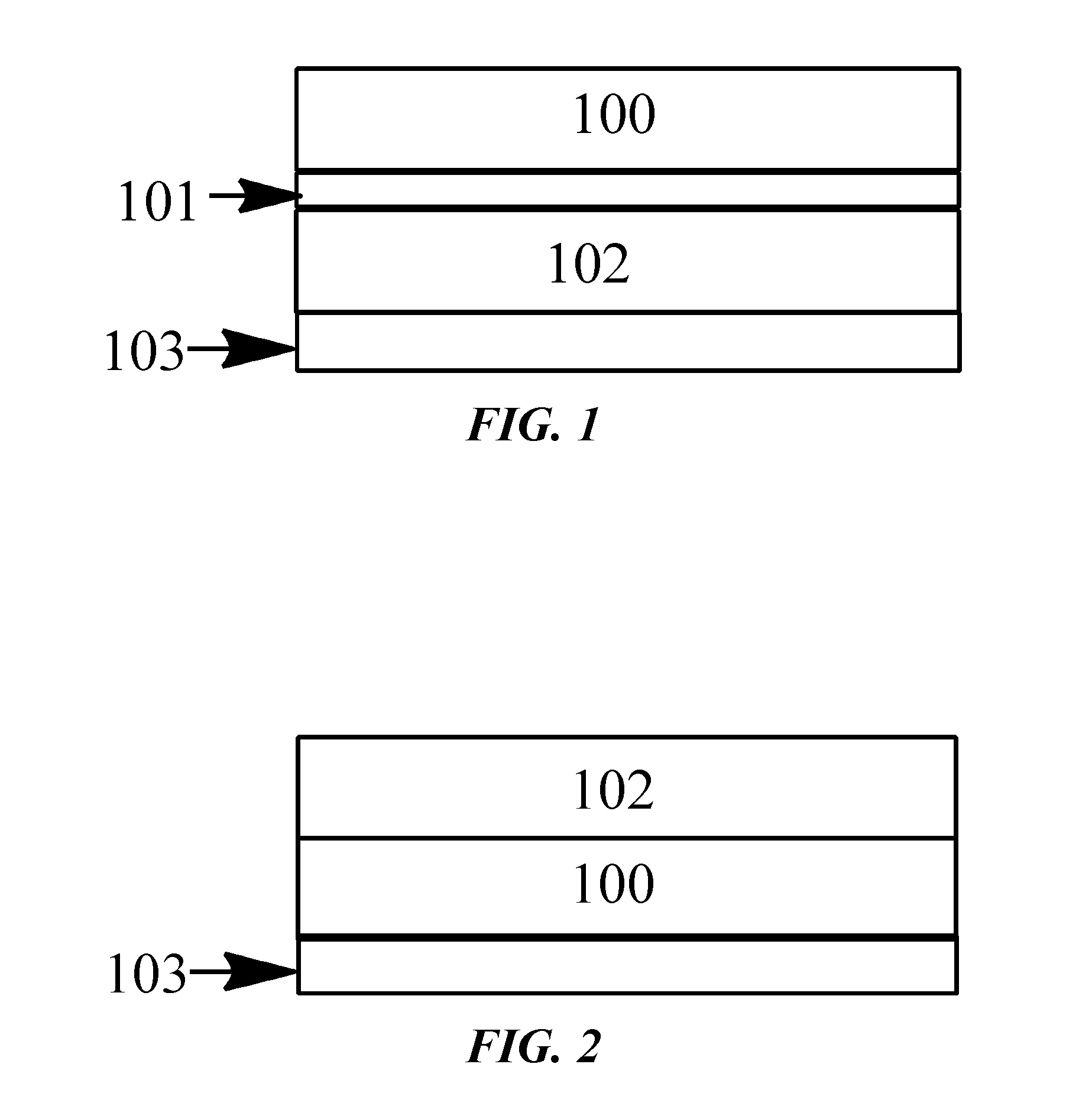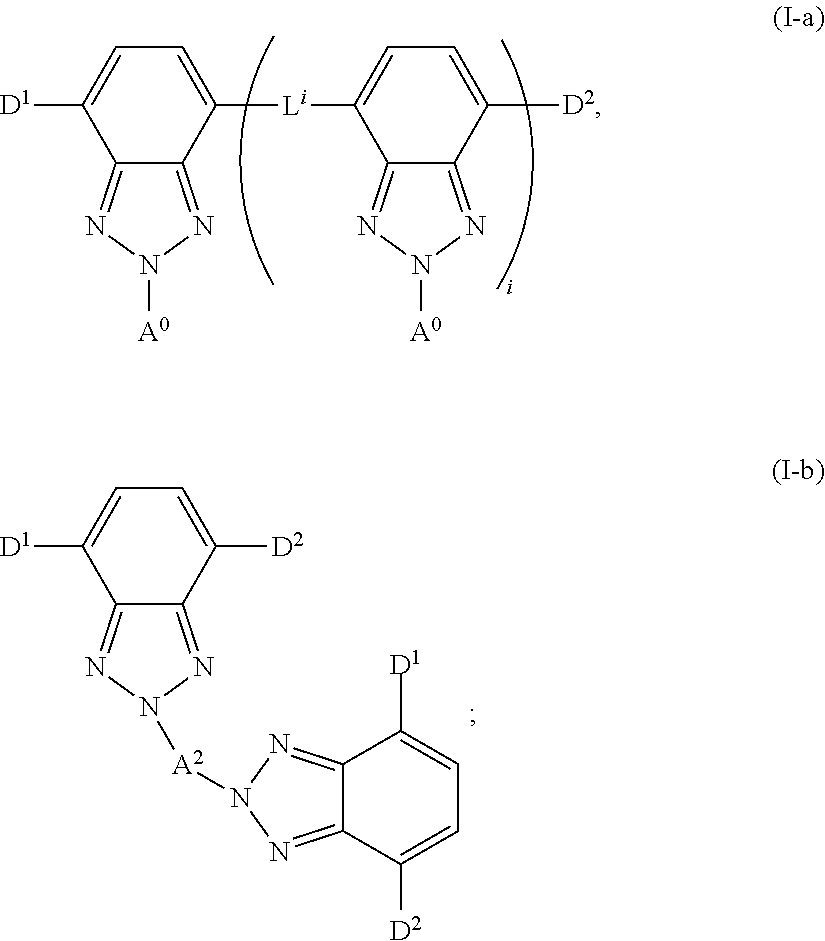Highly-fluorescent and photo-stable chromophores for enhanced solar harvesting efficiency
a chromophores, high luminescent technology, applied in the direction of instruments, optical elements, pyrene dyes, etc., can solve the problems of reducing the overall photoelectric conversion efficiency of the device, inability to effectively utilize the entire spectrum of light, so as to improve the performance of the photovoltaic device
- Summary
- Abstract
- Description
- Claims
- Application Information
AI Technical Summary
Benefits of technology
Problems solved by technology
Method used
Image
Examples
examples
[0124]The embodiments will be explained with respect to preferred embodiments which are not intended to limit the present invention. In the present disclosure, the listed substituent groups include both further substituted and unsubstituted groups unless specified otherwise. Further, in the present disclosure where conditions and / or structures are not specified, the skilled artisan in the art can readily provide such conditions and / or structures, in view of the present disclosure, as a matter of routine experimentation guided by the present disclosure.
[0125]For each example compound, the maximum absorption and fluorescence emission wavelength were measured in a solution and / or in a polyvinylbutyral (PVB) film. For example, in a dichloromethane solution of the obtained chromophore Example 1 (4,7-bis(4-(N,N-diphenylamino)phenyl)-2-(pyridin-4-yl)-2H-benzo[d][1,2,3]triazole), the maximum absorption of the chromophore was 451 nm and the maximum fluorescence absorption was 593 nm upon 470...
example synthesis
and Spectral Data
Intermediate A
[0127]Common Intermediate A is synthesized using a two step procedure.
Step 1: Synthesis of 2-(Pyridin-4-yl)-2H-benzo[d][1,2,3]triazole
[0128]A mixture of 4-chloropyridinium hydrochloride (25.0 g, 166 mmol), benzotriazole (29.6 g, 249 mmol), potassium carbonate (69.1 g, 500 mmol), and dimethylformamide (500 mL) was stirred and heated under argon at 130° C. for 3 days. After cooling, the solid was filtered off, and the solvent was evaporated under reduced pressure. The residue was treated with dichloromethane (200 mL), filtered and chromatographed using a column filled with silica gel (500 mL) and hexane / ethyl acetate (1:1) as an eluent. Fractions containing the desired product were combined, and the solvent was distilled off. The residue was triturated with ethanol, the solid was filtered off and dried in a vacuum oven to give 2-(pyridin-4-yl)-2H-benzo[d][1,2,3]triazole, 6.45 (20%). 1H NMR (400 MHz, CDCl3): δ 8.80 (m, 2H, pyridine), 8.26 (m, 2H, pyridine...
example 1
[0143]A mixture of Intermediate A (purity 90%, 1.95 g, 5 mmol), sodium carbonate (2.69 g, 25 mmol), 4-(diphenylamino)phenylboronic acid (3.47 g, 12 mmol), tetrakis(triphenylphosphine)palladium (0) (0.58 g, 0.5 mmol), water (20 mL), dioxane (80 mL), and toluene (10 mL) was heated under argon at 110° C. for 48 hours. The reaction mixture was poured into water (200 mL), diluted with dichloromethane (200 mL), treated with 2N NaOH (50 mL), stirred for 1 hour, and the dichloromethane layer was separated. The aqueous phase was washed with dichloromethane (200 mL). Both dichloromethane solutions were combined, dried over anhydrous sodium sulfate, and the solvent was removed under reduced pressure. The crude product was purified by column chromatography and recrystallization from ethyl acetate / ethanol (1:1) to give 4,7-bis(4-(N,N-diphenylamino)phenyl)-2-(pyridin-4-yl)-2H-benzo[d][1,2,3]triazole (Example 1), orange crystals, 1.71 g (50%). 1H NMR (400 MHz, CDCl3): δ 8.80 (m, 2H, pyridine), 8.3...
PUM
 Login to View More
Login to View More Abstract
Description
Claims
Application Information
 Login to View More
Login to View More - R&D
- Intellectual Property
- Life Sciences
- Materials
- Tech Scout
- Unparalleled Data Quality
- Higher Quality Content
- 60% Fewer Hallucinations
Browse by: Latest US Patents, China's latest patents, Technical Efficacy Thesaurus, Application Domain, Technology Topic, Popular Technical Reports.
© 2025 PatSnap. All rights reserved.Legal|Privacy policy|Modern Slavery Act Transparency Statement|Sitemap|About US| Contact US: help@patsnap.com



